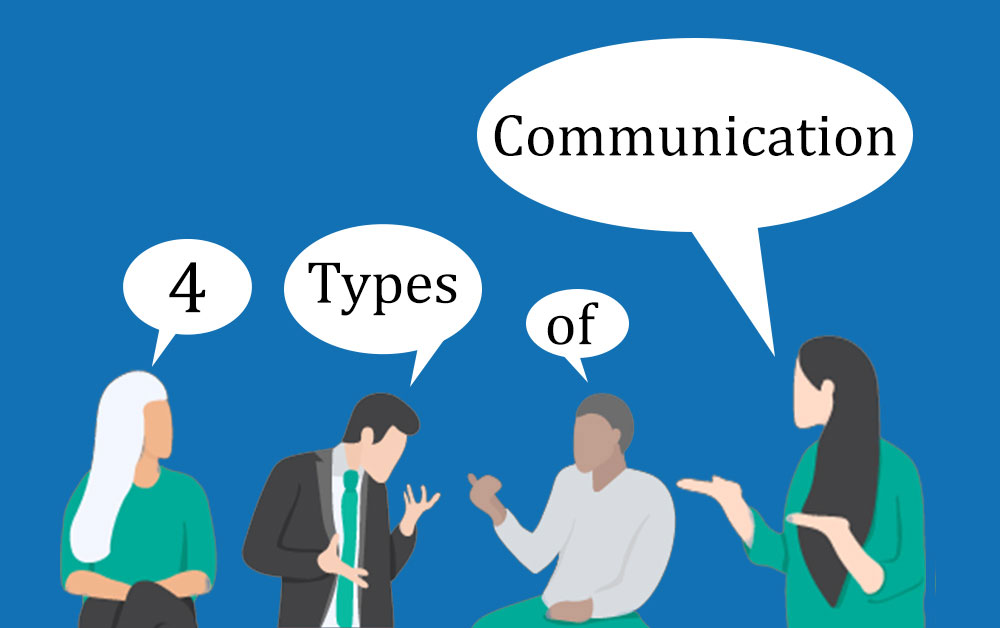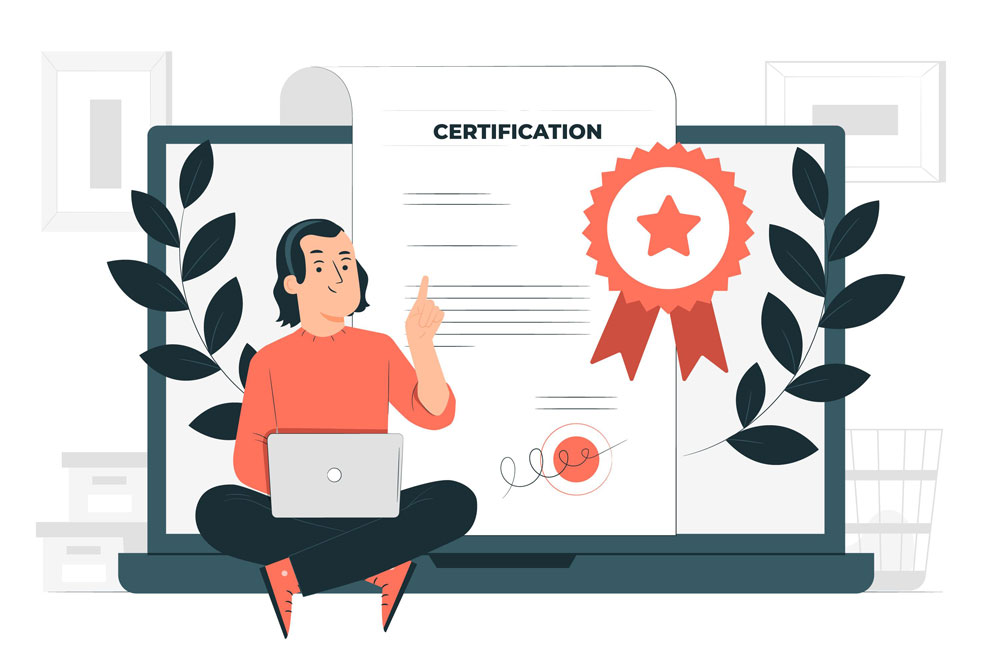4 Types of Communication & Its Tips For Effective Communication

An effectual communication skill is one of the top qualities that one needs to have to deliver the message effectively. It is highly valuable in both personal and professional life. However, communication styles vary from one person to another. In this article, we will discuss types of communication, and how one can use them to communicate impactfully in both private and professional life.
So, what are you waiting for? Let’s get started!
What Is Communication?
Are you wondering, “what is communication?” Communication is the process of sharing information from one person, group, or place to another. Each communication process involves at least one sender, message, and recipient. Nonetheless, many people consider communication to be a highly simple process. It may sound easy but it is one of the most complex subjects.
There are different means of communication such as radio, print, television, telegraph, phone, and more. However, the transmission of the message from the sender to the recipient can be impacted by multiple elements, including emotions, means of communication, cultural situation, language barrier, location, and more. When an individual is communicating, there can be unlimited recipients with multiple points of view. It is one of the reasons why people present different choices of words. An effective communicator will minimize the potential misunderstandings and overcome issues at every stage in the communication process. They will understand their audience and choose a powerful mode of communication to deliver the message.
Also Read: 7 cs of Communication
What Are Different Types of Communication?
Communication skills are highly essential for strong and healthy work culture. It is an act of sharing information from one person or group to another. However, there are 4 different types of communication: verbal communication, nonverbal communication, written communication, and visual communication.
Here, these are the 4 various types of communication that will help you jump ahead in the conversation:
- Verbal communication
- Nonverbal communication
- Written communication
- Visual communication

1. Verbal Communication
Verbal communication is one of the preeminent methods of communication that is done when two or more people speak with each other. It can either be face-to-face, conference call, skype, and more. Besides that, some verbal communications are also done in a casual format, such as casually speaking with a colleague in the office. Verbal communication is one of the most common types of communication that is often used during video conferences, phone calls, presentations, one-to-one conversations, and more.
2. Nonverbal communication
Nonverbal communication is one of the 4 types of communication that is used to communicate without words. Body posture, eye contact, and facial expressions are some of the preeminent elements of nonverbal communication. In simple words, it is the passive form of communication through which you represent your thoughts and feelings. You can also communicate and represent yourself via how you dress!
3. Written Communication
Written communication is one of the best techniques of communication, which is the act of writing, typing, and printing symbols to convey the message to the audience. It is highly helpful because it records the information in written form for reference. However, the information is generally shared through blogs, letters, books, pamphlets, memos, emails, and more. For better understanding, you can communicate your business planning writing form to ensure that everyone gets the same message for future reference.
4. Visual Communication
Visual communication is one of the other forms of communication that can be characterized as the preeminent helper of the organization. This type of communication can be used to provide a heavy amount of information. It is highly driven by social media platforms like YouTube, Instagram, and other digital platforms. In simple terms, it uses drawings, photographs, charts, graphs, and sketches to convey information.
Also Read: Sales Interview Questions and Answers
Importance Of Communication
Do you ever think about why communication is important in an organizational structure? Having strong communication skills eradicates numerous errors from an organization. Poor communication skills can often lead to misunderstandings and frustration among the employees, decreasing their productivity.
The importance of communication cannot be measured in a few elements. It is the key factor in the existence of business ventures. Multiple common barriers affect the communication within the organization. Lack of productive communication can lead to organizational failure.
Here are some of the common importance of communication that can help you:

1. Helps In Increasing Company’s Productivity
Any organization will acquire an increased success rate if the employees are communicating effectively. Providing sufficient information at the right time can save a lot of time and increase efficiency in the organization. It will also enhance teamwork and the employees’ relations.
2. Comfortable Working Space
An employee is only comfortable when he or she can communicate with his/her colleagues or subordinates. If communication is not happening in an organizational hierarchy, it will create mental chaos. It is crucial to fulfilling every employee’s requirement to work in the organization. It will bring productivity and motivate the employees to attain the company’s goal on time.
3. Firm Decision Making
To make the right decision in the organization, the employees, stakeholders, subordinates, and directors need to discuss respective topics. While exchanging ideas, the company may develop innovative elements that can help the organization make the right decision to achieve its goals. Apart from that, it will also keep the company well-structured.
4. Enhances Managerial Efficiency
Effective communications improved managerial efficiency. No organization can perform better and achieve its common goals without communicating. However, the manager’s efficiency depends on the way of communication with the members of the organization.
5. Build Job Satisfaction
Effective communication builds job satisfaction among the employees and increases confidence and trust among the management. Hence, the thin gap between the employees and management declines with communication. It promoted participation in the events conducted in the organization.
Also Read: Strength and Weakness
Tips For Effective Communication Process
Several interactions take place at a workplace, and improving it can create a major difference within the organization. Presenting some of the best tips for four effective communication types through which you can enhance your skills.
Verbal Communication Tips
1. Think Before You Speak
It is one of the best tips to become effective in verbal communication. Taking time before conveying the message permits you to organize your thoughts most concisely and concretely. If one rushes to provide the information without thinking, it might not come how you intended.
2. Know Your Audience
It is essential to understand your audience and think from their perspective to communicate your message in the best possible manner. People are different, and they have different opinions and knowledge. To ensure that they get your message easily, you need to understand them and discuss the technical topics. Hence, before presenting any information, ask your audience what they want and need. You can consider this a tailored approach to keep your audience interested in hearing the relevant information you provide.
3. Consider Your Body Language
Your body language can impact the overall message you deliver to your audience. While giving a presentation, you must be in relaxed body language, avoid biting your lips, stiffening your body, or crossing your arms. It will convey a sense of confidence in you, and people will be more interested in listening to you.
Nonverbal Communication Tips
1. A Good Eye Contact
If you are communicating nonverbally, the best thing to do is focus on having enthused eye contact. When people do not make eye contact while speaking, it is generally considered as they are trying to hide something. However, excessive eye contact can be too confrontational, so keep this in mind. It must look natural and comfortable to both the presenter and the audience.
2. Use Signals For Concluding Meaning
Verbal and nonverbal communication are correlated to each other. You can enhance its quality by adding relevant signals to what you are saying. It can be used in a conference meeting, giving presentations, or speaking in front of many people. The best thing to do is keep your weight balanced, stand firm, and keep your shoulders back to strike self-confidence.
3. Practice Being Available In The Present
Being available at the moment while communicating is one of the most integrated things to keep in mind. When you are aware of your audience and surroundings, you can communicate more efficiently. It will keep you in control of what you are going to say.
Written Communication Tips
1. Know What You Want To Inform
If you do not get a hold of what you want to share, there is no way your reader will understand. Hence, before you present it, you take a notepad and pen, make points of what you will say, and practice. You should make it clear what you want them to do.
2. Keep It Short & Simple
Do not use jargon words when you address the general audience as not all of them would be familiar with the respective terms. The most effective messages are written in short and simple language, making it easier for everyone to understand.
3. Proofread What You Write
Typos and grammatical errors are the most common mistakes. If you do not make it right, it will look unprofessional. Therefore, give it an advance look, go through whatever you write, and make the respective changes. There are different grammatical checker tools available online that will help you with language, grammar, and spelling.
Visual Communication Tips
1. Focus On Fonts & Colors
A visual rule that most companies keep in mind while creating visual communication is not to use more than five colors in a single layout. Hence, you should use colors to highlight the essential information you want to provide to the audience. All the fonts used in the content should be readable and appropriate, suiting the communication style.
2. Maintain The Familiarity
When you are representing a piece of graphic information, you must use the familiar icons for the message you are providing. You should use familiar language, references, and symbols and use hard-hitting metaphors to make sense.
3. Add Varieties Of Visual Communication
The best way to attract your audience’s attention is by adding attractive animations such as photos, animated videos, GIFs, and more where it is relevant. Apart from this, you can share recent shocking statistics using infographics.
Also Read: Interview Questions and Answers
Communication Barriers
You must have heard that communication is one of the most effective keys to keeping an organization moving forward. It enables the organization to pass information to other people in the organization and help them understand the shared common goal. It helps remove streamline collaboration, confusion, enhances productivity, and motivates employees. However, effective communication is not as easy as you think. When it comes to communicating, multiple barriers come in between. There are several types of communication that happen within the organization, which faces multiple communication barriers. In this article, you will learn about types of communication barriers.
Types Of Communication Barriers
1. Physical Communication Barriers
Communication would be a lot easier if it happened over a shorter distance. However, modern advancements in technology have helped decrease the impact of physical barriers. In simple words, it is natural, and it can be referred to as a physical factor that distracts the communicator and influences the flow of communication.
2. Cultural Communication Barriers
Cultural communication barriers are one of the most common communication barriers that impact the flow of information. If you are working in an organization with multiple employees of different backgrounds, you might come across multiple challenges in terms of communication. The prominent reasons can be understanding culture, ethics, values, and preferences.
3. Language Communication Barriers
Have you ever come across someone who does not speak the same language as you do? If yes, you must be aware of the difficulty of sharing and understanding the information. Hence, it is one of the reasons why language plays a vital role in communication.
4. Gender Barriers
There have been many stereotypes and generalized communications based on men and women interacting differently. However, some of them are true, and others are void. Hence, when communicating in a workspace, it is essential to pay attention to improving work collaboration.
5. Emotional Communication Barriers
Emotions and communication are highly related to each other. Emotions like fear, anger, mistrust can affect the entire flow of communication and make it difficult to deliver the message in the most direct, polite, and honest way. It is one of the integrated communication barriers you’d need to work on.
2 Types of Organisational Communication
Communication is a crucial part of life, as it is the process where people share their ideas, thoughts, opinions, and information by communicating with one another. It can be in any form be it written, visual, verbal, or nonverbal. However, communication is categorized into two different segments: formal and informal communication. Many people get confused between these two types of communication, so here we are explaining the Difference between Formal and Informal Communication.

Meaning of Formal and Informal Communication
1. Formal Communication
Formal communication is the process of sharing information via properly emphasized channels. It follows the hierarchical structure created in an organization to eradicate unnecessary chaos. The communication structure is typically from downward to upward in respective departments. Hence, all the employees working in the organization are bound to follow the communication channels and perform roles and responsibilities. It is considered one of the most effective forms of communication. This form of communication ensures that information is reached out to the people correctly because more importance is given to the rules.
Examples: Distributing reports, business letters, orders, and offering letters to the employees verbally and nonverbally are common examples of formal communication.
2. Informal Communication
Informal communication is a multi-dimensional form of communication that moves freely in the organization. Any established channels and routes do not bind it. It is a quick form of communication that is more conceptual than formal communication. In simple words, it is one of the most natural forms of communication, where people interact with each other freely without any barriers. It is a spontaneous form of communication, where subordinates and superiors can talk freely. There are no bounded rules, guidelines, or systems to communicate.
Examples: Verbal communication regarding multiple job roles, peer-to-peer communication, text messages, cultural slang, the interaction between the employees, etc., are some of the common examples of informal communication.
Difference Between Formal and Informal Communication
1. Operational Activities
Formal communication is developed to provide day-to-day activities to the employees in an organization, and it is a significant difference between formal and informal communication. It is highly effective in larger businesses classified from top-to-bottom and bottom-to-top management. Whereas in informal communication, the channels are not formal and do not include any day-to-day activities.
2. Reliability
Formal communication is one of the most reliable forms of communication compared to informal communication. Informal communication is shared through proper, highly accurate channels, including documented information for every piece of information. There is no documented evidence available in informal communication, as it is very rapid and less reliable.
3. Time Differences
A key difference between formal and informal communication is that formal communication follows an organized and structured communication approach. It is highly time-consuming compared to other channels because it is attested and passed by the respective personnel after checking the facts, figures, and accuracy. Informal communication is the quickest form of communication, which can be done anywhere without any time-bound.
Types for Formal Communication
- Upward Communication: Upward communication is the type of communication that is transmitted from lower to higher levels. It helps in motivating the employees. Some of the common upward communication consists of instructions, suggestions, reports, instructions, complaints, and more.
- Downward Communication: It is one of the most effective ways of communication, where superiors of the company interact with subordinates. It includes tasks, orders, emails, letters, etc.
- Horizontal Communication: Horizontal communication happens between individuals of the same age or levels within an organization, but having varied responsibilities. Interaction between managers of different departments such as sales, HR, accounts, etc., are significant examples of horizontal communication.
- Diagonal Communication: It is a form of communication, where employees of different departments interact without being bound to rules and commands. Interaction between the sales team and the HR manager is one of the prominent examples.
Also Read: Leave Application Format
Types of Informal Communication
- Single-chain: is an informal communication in which the information is passed from one person to another in a single chain. In this process, the first employee provides the information to the second employee, and it goes on.
- Probability Chain: In this type of informal communication, the employee interacts and shares the same information with other people randomly. He does not stick to the terms and conditions that sharing such information can put a company’s image at risk, knowing that a particular individual is not associated with the company.
- Gossip Chain: In gossip chain communication, the employees interact with each other most informally, and talk about multiple things, which might not be job-oriented.
- A cluster Chain: is a form of communication where one person shares the news with a specific person or group. In this type of communication, that specific person or group keeps the information or shares it with selected people.
Conclusion
Now you know the four types of communication and how it is essential for your personal and professional life. You can practice these tips to communicate with your employees in an organization effectively. It will help you achieve the common goal and enhance your communication skills. In addition, good communication skills are vital for the company’s managers, directors, and stakeholders to guide the employees towards success. Besides, it will also help them perform their roles and responsibilities like planning, organizing, controlling, and executing successfully.
Search Articles
Categories
- 54
- 19
- 6
- 161












